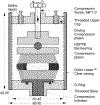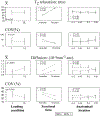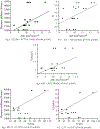MR diffusion is sensitive to mechanical loading in human intervertebral disks ex vivo
- PMID: 24889510
- PMCID: PMC9205197
- DOI: 10.1002/jmri.24624
MR diffusion is sensitive to mechanical loading in human intervertebral disks ex vivo
Abstract
Purpose: To use T2 and diffusion MR to determine the change in the mechanical function of human disks with increased degenerative state.
Materials and methods: Spatial changes in T2 and diffusion were quantified in five cadaveric human lumbar disks under compressive loads. Regression models were used to investigate the relationship between the change in MR parameters and the disk's dynamic and viscoelastic properties.
Results: Compressive loading caused a significant reduction in the disk's mean diffusivity ([11.3 versus 9.7].10(-4) .mm(2) /s, P < 0.001) but little change in T2 (P < 0.05). Diffusivity and T2 were correlated with the disk's dynamic (P < 0.01 and P < 0.05) and long-term viscoelastic (P < 0.05 and P < 0.05) stiffness. Diffusivity but not T2, was correlated with its viscoelastic dampening (r(2) = 0.45, P < 0.01) and instantaneous stiffness (r(2) = 0.44, P < 0.05). Nucleus diffusivity was significantly higher than the annulus's (-21% to -4%, P < 0.01). MR-estimated hydration was correlated with the instantaneous viscoelastic stiffness of the nucleus (r(2) = 0.35, P < 0.05) and the dynamic (r(2) = 0.44, P < 0.05) and long-term viscoelastic (r(2) = 0.42, P < 0.05) stiffness in the annulus. T2 correlated with diffusivity at low load (r(2) = 0.66, P < 0.05), but not at high load.
Conclusion: The strong correlations between diffusivity and the rheological assessments of disk mechanics suggest that MR might permit quantitative assessment of disk functional status and structural integrity.
Keywords: MR diffusivity; T2 relaxation; degeneration; intervertebral disc; mechanical competence.
© 2014 Wiley Periodicals, Inc.
Figures







Similar articles
-
Diffusion based MR measurements correlates with age-related changes in human intervertebral disks.Clin Biomech (Bristol). 2019 Jan;61:38-45. doi: 10.1016/j.clinbiomech.2018.06.007. Epub 2018 Jun 18. Clin Biomech (Bristol). 2019. PMID: 30458331 Free PMC article.
-
Disc degeneration assessed by quantitative T2* (T2 star) correlated with functional lumbar mechanics.Spine (Phila Pa 1976). 2013 Nov 15;38(24):E1533-40. doi: 10.1097/BRS.0b013e3182a59453. Spine (Phila Pa 1976). 2013. PMID: 23921323 Free PMC article.
-
The degenerative state of the intervertebral disk independently predicts the failure of human lumbar spine to high rate loading: an experimental study.Clin Biomech (Bristol). 2015 Feb;30(2):211-8. doi: 10.1016/j.clinbiomech.2014.09.016. Epub 2014 Oct 7. Clin Biomech (Bristol). 2015. PMID: 25579978 Free PMC article.
-
Structure and biology of the intervertebral disk in health and disease.Orthop Clin North Am. 2011 Oct;42(4):447-64, vii. doi: 10.1016/j.ocl.2011.07.012. Orthop Clin North Am. 2011. PMID: 21944583 Review.
-
Recent advances in analytical modeling of lumbar disc degeneration.Spine (Phila Pa 1976). 2004 Dec 1;29(23):2733-41. doi: 10.1097/01.brs.0000146471.59052.e6. Spine (Phila Pa 1976). 2004. PMID: 15564922 Review.
Cited by
-
Spine biomechanical testing methodologies: The controversy of consensus vs scientific evidence.JOR Spine. 2021 Jan 5;4(1):e1138. doi: 10.1002/jsp2.1138. eCollection 2021 Mar. JOR Spine. 2021. PMID: 33778410 Free PMC article. Review.
-
Tissue Engineering a Biological Repair Strategy for Lumbar Disc Herniation.Biores Open Access. 2015 Nov 1;4(1):431-45. doi: 10.1089/biores.2015.0034. eCollection 2015. Biores Open Access. 2015. PMID: 26634189 Free PMC article. Review.
-
A comparative study of diffusion kurtosis imaging and T2* mapping in quantitative detection of lumbar intervertebral disk degeneration.Eur Spine J. 2019 Sep;28(9):2169-2178. doi: 10.1007/s00586-019-06007-z. Epub 2019 May 15. Eur Spine J. 2019. PMID: 31093750
-
Comparison and optimization of b value combinations for diffusion-weighted imaging in discriminating hepatic fibrosis.Abdom Radiol (NY). 2024 Apr;49(4):1113-1121. doi: 10.1007/s00261-023-04159-7. Epub 2024 Jan 29. Abdom Radiol (NY). 2024. PMID: 38285179
-
Acute Physiological Response of Lumbar Intervertebral Discs to High-load Deadlift Exercise.Magn Reson Med Sci. 2021 Sep 1;20(3):290-294. doi: 10.2463/mrms.mp.2020-0052. Epub 2020 Sep 1. Magn Reson Med Sci. 2021. PMID: 32879259 Free PMC article.
References
-
- Andersson GBJ. Epidemiological features of chronic back pain. Lancet 1999;354:581–585. - PubMed
-
- Cassar-Pullicino VN. MRI of the ageing and herniating intervertebral disc: review. Eur J Radiol 1998;27:214–228. - PubMed
-
- Boos N, Boesch C. Quantitative magnetic resonance imaging of the lumbar spine. Potential for investigations of water content and biochemical composition. Spine 1995;20:2358–2365. - PubMed
-
- Modic MT. Degenerative disc disease and back pain. Magn Reson Imaging Clin North Am 1999;7:481–491. - PubMed
-
- Buirski G, Silberstein M. The symptomatic lumbar disc in patients with low-back pain. Magnetic resonance imaging appearances in both a symptomatic and control population. Spine 1993; 18:1808–1811. - PubMed
Publication types
MeSH terms
Grants and funding
LinkOut - more resources
Full Text Sources
Other Literature Sources

